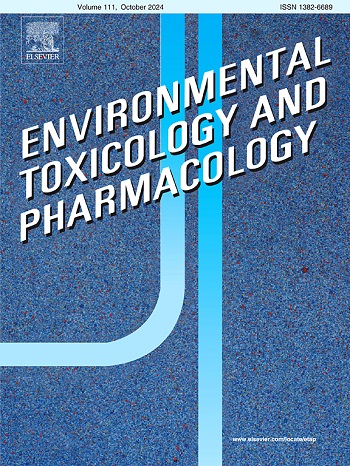Evaluation of histological architecture, cellular apoptosis, dinitrophenyl protein and superoxide dismutase expressions in the gills of goldfish exposed to environmentally relevant pesticide mixtures: Potential mechanisms to disrupt osmoregulation
IF 4.2
3区 环境科学与生态学
Q2 ENVIRONMENTAL SCIENCES
引用次数: 0
Abstract
Pesticides are regularly used in agricultural production to increase crop yields and eliminate targeted pests. Unfortunately, these pesticides enter aquatic environments through surface runoff. In this study, we examined the effects of short-term exposure (one-week) to environmentally relevant pesticide mixtures (alconifen, atrazine, azinphos-methyl, isoproturon, linuron, metolachlor, pendimethalin, and tebucanazole) on gill architecture, oxidative stress biomarker, and cellular apoptosis in goldfish (Carassius auratus). Histological analysis revealed morphological alterations in the gills of fish exposed to both low- and high-dose pesticide mixtures. Immunohistological and real-time PCR results showed a significant upregulation of dinitrophenyl protein and superoxide dismutase mRNA expressions in the gills of fish exposed to pesticide mixtures. In situ TUNEL assay demonstrated a substantial increase in apoptotic nuclei in the gills of fish exposed to pesticide mixtures. Together, these results suggest that short-term exposure to environmentally relevant pesticide mixtures disrupts the morphology and cellular functions in the gills of teleost fishes.
暴露于环境相关农药混合物的金鱼鳃组织结构、细胞凋亡、二硝基苯蛋白和超氧化物歧化酶表达的评估:破坏渗透调节的潜在机制
农药在农业生产中经常使用,以提高作物产量和消灭目标害虫。不幸的是,这些农药通过地表径流进入水生环境。在这项研究中,我们研究了短期(一周)暴露于环境相关的农药混合物(阿克芬、阿特拉津、甲基氮磷、异丙醇、利努龙、异丙草胺、对二甲脒和戊卡唑)对金鱼(Carassius auratus)鳃结构、氧化应激生物标志物和细胞凋亡的影响。组织学分析显示,暴露于低剂量和高剂量农药混合物的鱼鳃的形态学改变。免疫组织学和实时荧光定量PCR结果显示,农药混合物对鱼鳃中二硝基苯蛋白和超氧化物歧化酶mRNA的表达有显著上调。原位TUNEL试验表明,暴露于农药混合物的鱼鳃中凋亡细胞核大量增加。总之,这些结果表明,短期暴露于环境相关的农药混合物会破坏硬骨鱼鳃的形态和细胞功能。
本文章由计算机程序翻译,如有差异,请以英文原文为准。
求助全文
约1分钟内获得全文
求助全文
来源期刊
CiteScore
7.00
自引率
4.70%
发文量
185
审稿时长
34 days
期刊介绍:
Environmental Toxicology and Pharmacology publishes the results of studies concerning toxic and pharmacological effects of (human and veterinary) drugs and of environmental contaminants in animals and man.
Areas of special interest are: molecular mechanisms of toxicity, biotransformation and toxicokinetics (including toxicokinetic modelling), molecular, biochemical and physiological mechanisms explaining differences in sensitivity between species and individuals, the characterisation of pathophysiological models and mechanisms involved in the development of effects and the identification of biological markers that can be used to study exposure and effects in man and animals.
In addition to full length papers, short communications, full-length reviews and mini-reviews, Environmental Toxicology and Pharmacology will publish in depth assessments of special problem areas. The latter publications may exceed the length of a full length paper three to fourfold. A basic requirement is that the assessments are made under the auspices of international groups of leading experts in the fields concerned. The information examined may either consist of data that were already published, or of new data that were obtained within the framework of collaborative research programmes. Provision is also made for the acceptance of minireviews on (classes of) compounds, toxicities or mechanisms, debating recent advances in rapidly developing fields that fall within the scope of the journal.

 求助内容:
求助内容: 应助结果提醒方式:
应助结果提醒方式:


